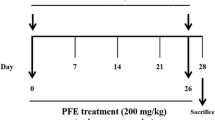Summary
A rat model for benign prostatic hyperplasia in man (BPH) was investigated. Citral treatment of male Copenhagen rats for 4 months via the transdermal route resulted in a marked hyperplasia of glandular epithelium and interglandular stroma in the ventral prostate. Despite the cellular hyperplasia there was not a significant increase in prostate weight. Investigations of the mechanism of action of citral showed that application of citral directly to the vagina in female, ovariectomized rats resulted in an increased proliferation of vaginal epithelium and a significant increase in the BrdUrd incorporation in vaginal epithelial cells, in short a similar effect to that of estrogen application. In an in vitro assay citral proved to inhibit estrogen binding to estrogen receptors, while no such inhibition was observed with testosterone for androgen receptors. These observations together with the estrogen implication in the BPH and the reported incidence of gynccomastia following exposure to geraniol, a precursor of citral, strongly suggest that the prostatic hyperplasia-inducing capacity of citral may be due to its estrogenic action.
Similar content being viewed by others
References
Abramovici A, Sandbank U (1988) The mortician's mystery solved? N Engl J Med 319: 1157
Abramovici A, Servadio C, Sandbank U (1985) Benign hyperplasia of ventral prostate in rats induced by a monoterpene (preliminary report). Prostate 7: 389
Abramovici A, Servadio C, Shmuely J, Sandbank U (1987) Experimental induction of atypical hyperplasia in rat ventral prostat. In: Murphy GP, Khoury S, Küss R, Chatelain C, Denis L (eds) Prostate cancer, part A: Research, endocrine treatment and histopathology. Liss, New York, p 559
Berry SJ, Coffey DS, Walsh PC, Ewing LL (1984) The development of human prostatic hyperplasia with age. J Urol 132: 474
Berry SJ, Coffey DS, Ewing LL (1985) A comparison of human and canine benign prostatic hyperplasia. In: Bruchovsky N, Chapdelaine A, Neumann F (eds) Regulation of androgen action. Brückner, Berlin (West), p 59
Berry SJ, Strandberg JD, Saunders WJ, Coffey DS (1986) Development of canine benign prostatic hyperplasia with age. Prostate 9: 363
Brendler CB, Berry SJ, Ewing LL, McCullough AR, Cochran RC, Strandberg JD, Zirkin BR, Coffey DS, Wheaton L, Hiler M, Bordy MJ, Niswender GD, Scott WW, Walsh PC (1983) Spontaneous benign prostatic hyperplasia in the beagle. Age-associated changes in serum hormone levels, and the morphology and secretory function of the canine prostate. J Clin Invest 71: 1114
Chung LWK, Matsuura J, Runner MN (1984) Tissue interactions and prostatic growth: I. Induction of adult mouse prostatic hyperplasia by fetal urogenital sinus implants. Biol Repord 31: 155
Connor MJ (1991) Modulation of tumor promotion in mouse skin by the food additive citral (3,7-dimethyl-2,6-octadienal). Cancer Lett 56: 25
DeKlerk DP, Coffey DS, Ewing LL, McDermontt IR, Reiner WG, Robinson CH, Scott WW, Strandberg JD, Talalay P, Walsh PC, Wheaton LG, Zirkin BR (1979) Comparison of spontaneous and experimentally induced canine prostatic hyperplasia. J Clin Invest 64: 842
Diliberto JJ, Usha G, Birnbaum LS (1988) Disposition of citral in male Fisher rats. Drug Metab Dispos 16: 721
Habenicht U-F, ElEtreby MF (1988) The periurethral zone of the prostate of the cynomolgus monkey is the most sensitive prostate part for an estrogenic stimulus. Prostate 13: 305
Habenicht U-F, ElEtreby MF (1989) Selective inhibition of androstenedione-induced prostate growth in intact beagle dogs by a combined treatment with the antiandrogen cyproterone acetate and the aromatase inhibitor 1-methyl-androsta-1,4-diene-3,17-dione (1-methyl-ADD). Prostate 14: 309
Habenicht U-F, Schwarz K, Neumann F, ElEtreby MF (1987) Induction of estrogen-related hyperplastic changes in the prostate of the cynomolgus monkey (Macaca fascicularis) by androstenedione and its antagonization by the aromatase inhibitor 1-methyl-androsta-1,4-diene 3,17-dione. Prostate 11: 313
Isaacs JT (1984) Common characteristics of human and canine benign prostatic hyperplasia. Prog Clin Biol Res 145: 217
Juniewicz PE, Lemp BM, Barbolt TA, LaBrie TK, Batzold FH, Reel JR (1989) Dose-dependent hormonal induction of benign prostatic hyperplasia (BPH) in castrated dogs. Prostate 14: 341
Juniewicz PE, Lemp BM, Barbolt TA, Labrie TK, McCarty M, Reel JR, Batzold FH (1990) Effect of steroidal androgen receptor antagonist Win 49,596 on steroid induced benign prostatic hyperplasia in the castrate beagle dog. Prostate 16: 1
Kozák I, Bartsch W, Krieg M, Voigt K-D (1982) Nuclei of stroma: site of highest estrogen concentration in human prostatic hyperplasia. Prostate 3: 433
McNeal JE (1983) Relationship of the origin of benign prostatic hypertrophy to prostatic structure of man and other mammals. In: Hinman F Jr (ed) Benign prostatic hyperplasia. Springer, New York, p 153
Sandbank M, Abramovici A, Ben-David E (1988) Sebaceous gland hyperplasia following application of citral. An ultrastructural study. Am J Dermatopathol 10: 415
Schulze H, Claus S (1990) Histological localization of estrogen receptors in normal and diseased human prostates by immunocytochemistry. Prostate 16: 331
Servadio C, Abramovici A, Sandbank U, Savion M, Rosen M (1986) Early stages of the pathogenesis of rat ventral prostate hyperplasia induced by citral. Eur Urol 12: 195
Sikes RA, Thomsen S, Petrow V, Neubauer BL, Chung LWK (1990) Inhibition of experimentally induced mouse prostatic hyperplasia by castration or steroid antagonist administration. Biol Reprod 43: 353
Walsh PC, Wilson JD (1976) The induction of prostatic hypertrophy in the dog with androstanediol. J Clin Invest 57: 1093
Author information
Authors and Affiliations
Rights and permissions
About this article
Cite this article
Geldof, A.A., Engel, C. & Rao, B.R. Estrogenic action of commonly used fragrant agent citral induces prostatic hyperplasia. Urol. Res. 20, 139–144 (1992). https://doi.org/10.1007/BF00296526
Accepted:
Issue Date:
DOI: https://doi.org/10.1007/BF00296526




